
高齢化社会のデザインに関する韓日比較研究
Research Map for comparative studies on desinging for hyper-aging societies, in process

アウトライン
韓国と日本の両社会は、東アジアでも急速 に高齢化を とげている。韓国統計庁は、将来の人口推計を発表したが、65歳以上高齢者は2065年には46%に達し、高齢化比率では日本を抜いてOECD加盟の先進 国のなかで首位になると予測した。その原因は韓国も日本も少子化と高齢化という二大要因である。韓国政府は2016年からの3カ年で約120兆ウォン (11兆円)を投下したが出生率の改善はみられなかった(日経 20190328)。少子化では先行する日本政府は1990年代以降、出生率の低下に具体的な策を講じることができ ず、2012年以降には、働き方改革における高齢化に即応した一連の対策(外国人労働者の受け入れ拡大、保育所の充実、高齢労働力の活用、年金開始年齢の 引き上げ)に乗り出している。文化的には韓国と日本は儒教圏の伝統をもち長幼の礼を重んじるが、近代化以降の、高齢福祉政策や老人像のイメージ、あるい は、老年精神医学を巻き込んだ認知症対策などで、相違する点が多い。しかしながら両国とも、高齢者医療福祉ケア対策において共通の課題があるにも関わら ず、現今の高齢者に対する保健福祉サービスに対する情報交流がない。本研究は、急速な高齢化に長寿社会である韓日両国の「変貌する高齢者像」について、韓 日両国の文化人類学者によるエスノグラフィーとそれにもとづく文献研究を通して、韓日の高齢者像の近年の歴史的変遷と歴史的文脈に関する分析をおこない、 その成果を日韓の学会ならびに市民向けのワークショップで公開する。研究班は日本側2名(申請者、在日コリアン大学研究者)、韓国側2名(大学研究者)の 合計4名で行う。申請者は2018、2019年に韓国文化人類学会で英語による発表(代表者個人の活動の項目参照)を行い、在日コリアン研究者は2018 年の医学保健系の国際シンポジウムの分科会組織経験者である。そのため共同研究者のメンバーの意思疎通もできており、本申請課題に関する情報交換も電子 メールやSNSを使いすでに開始している。
★現状分析("Aging of South Korea"より)
| In demographic
terms, aging refers to an increase in the proportion of senior citizens
to the total population. The term "senior citizen" encompasses those
aged 65 or older.[1] In 2045, South Korea
is projected to become the world's most aged population, surpassing
Japan. Senior citizens will reach 46.5 percent of the population in
2067, outnumbering the working age population.[2] Aging is often caused by the dramatic improvement of living standards derived from the development of science and medicine, increasing the life expectancy of the average individual; however, a decrease in birth rates can be a major contributor. South Korea's birth rate has declined since 1960, becoming a prominent issue within the country.[3] Until the 1980s, it was widely believed that this demographic trend would end and that the population would eventually stabilize, but birth rates continued to decrease.[3] In 2021, this culminated in South Korea experiencing a natural population decline for the first time in its history.[4][5] Analysts state that South Korea's current low birth rates are caused by the country's high economic inequality, including the high cost of living, low wages for an OECD member country, lack of job opportunities, as well as rising housing unaffordability.[6] 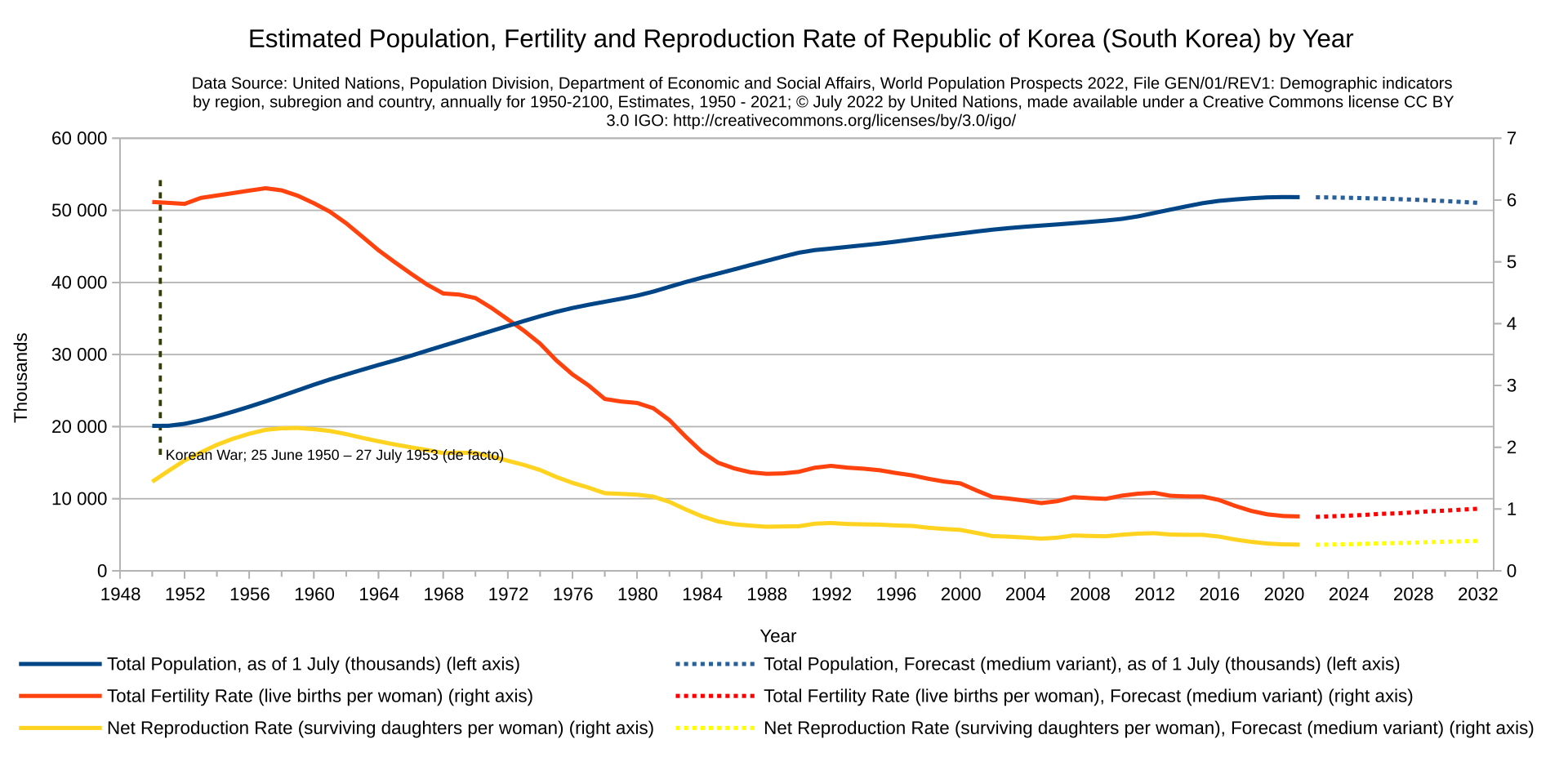 South Korea's population, fertility rate and net reproduction rate, 2022 South Korea's portion of the elderly population is projected to grow at the fastest pace in the world, from 14.9 percent in 2019 to 46.5 percent in 2067.[7] Consequently, this will lead to South Korea's population declining sharply within the next few decades to about 25–30 million, down from 51 million as of 2022. |
人口統計学的に、高齢化とは総人口に占める高齢者の割合が増加すること
を指す。「高齢者」という用語は65歳以上の者を指す。[1]
2045年には、韓国は日本を抜いて世界で最も高齢化が進んだ国になると予測されている。2067年には高齢者が人口の46.5%を占め、生産年齢人口を
上回る見通しである。[2] 高齢化は、科学や医学の発展による生活水準の劇的な向上が平均余命を延ばすことで引き起こされることが多いが、出生率の低下も大きな要因となり得る。韓国の出生率は1960年以降低下しており、国内で大きな問題となっている。 1980年代までは、この人口動態の傾向は終わり、人口は最終的に安定すると広く考えられていたが、出生率は低下し続けた。[3] 2021年には、韓国は歴史上初めて自然人口減少を経験することとなった。[4][5] アナリストらは、韓国の現在の低出生率は、生活費の高さ、OECD加盟国としては低い賃金、雇用機会の不足、住宅費の高騰など、同国の高い経済的不平等が原因であると述べている。[6]  韓国の人口、出生率、純再生産率、2022年 韓国の高齢者人口の割合は、2019年の14.9%から2067年には46.5%へと、世界で最も速いペースで増加すると予測されている。[7] その結果、韓国の人口は今後数十年で急激に減少し、2022年の5,100万人から2,500~3,000万人程度にまで減少すると見込まれている。 |
| Causes The main cause of South Korea's aging is low fertility. Decreased fertility rates tend to be caused by lower marriage rates, more delayed marriages, and increased age of parents. Existing research suggests that economic factors such as income, labor market conditions, as well as socio-cultural factors – including changes in the values of education and gender roles, and family and health policy – are the main causes of lower fertility rates.[8] Fertility 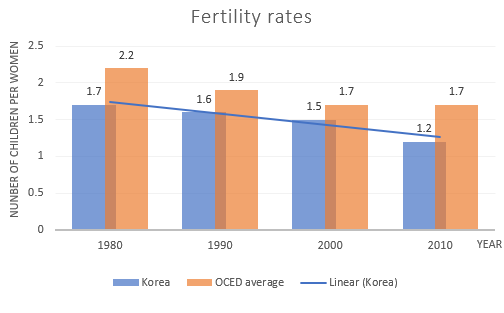 Fertility rates in Korea and the OECD average, 1980 to 2010 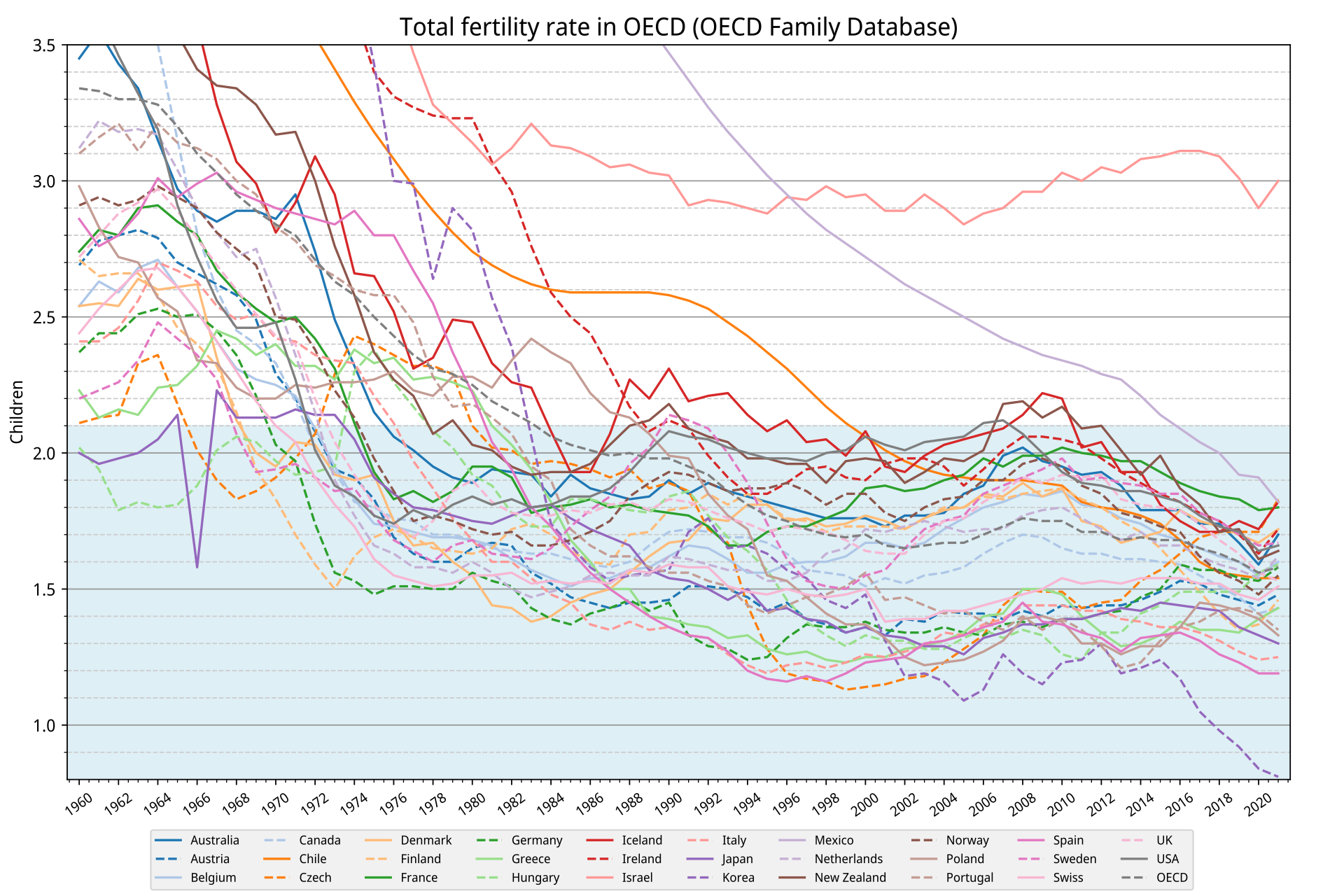 The total fertility rate in OECD countries, 2023 Unlike countries in Europe where fertility rates naturally fell below the level of population replacement due to industrialization and socio-cultural factors, Korea's birth rates fell sharply due to birth control policies. Korea's birth control policy began in the 1960s and ended in the mid-1990s when birth rates fell significantly below the level of population replacement. As a result, Korea's fertility rate declined by about half from the end of the 1970s (2.90 births/woman) to 1.56 births/woman at the end of the 1980s.[9] In the 2000s, when low birth rates started to become a problem, the government tried to alter policy to increase it, but the birth rate still declined at a more rapid rate than any other country.[8] On the other hand, the Korean population tends to have more males than females due to the traditional preference for male babies in Korea. Other developed nations with a more balanced sex ratio have had less population degrowth. This suggests that if the South Korean preference for male babies is weakened, balancing the gender ratio, the negative effect on the birth rate may be removed.[8] The South Korean fertility rate of 1.8 children per woman was below the OECD average fertility rate of 2 children per woman in 1984 and has remained below average since then.[9] In 2018, the total fertility rate in South Korea declined to 0.98.[10] In order to maintain a population of 50 million, the fertility rate would need to match the replacement level of 2.1.[10] Among OECD countries, Korea was the only country whose fertility rate declined below 1.[10] The number of newborn babies declined 8.6% from 2017 to 2018, becoming the lowest birth rate for South Korea.[10] In 2022, the fertility rate declined further to 0.81.[11] Sejong City is the only area where the population is expected to increase.[12] |
原因 韓国の高齢化の主な原因は出生率の低下である。出生率の低下は、婚姻率の低下、晩婚化、親の高齢化によって引き起こされる傾向がある。既存の研究では、所 得、労働市場の状況などの経済的要因、および教育や性別役割、家族や保健政策における価値観の変化などの社会文化的要因が、出生率低下の主な原因であるこ とが示唆されている。[8] 出生率  韓国とOECD平均の合計特殊出生率、1980年~2010年  OECD諸国の合計特殊出生率、2023年 工業化や社会文化的な要因により、合計特殊出生率が人口置換水準を下回るようになったヨーロッパ諸国とは異なり、韓国の出生率は避妊政策により急激に低下 した。韓国の出生抑制政策は1960年代に始まり、出生率が人口置換水準を大幅に下回った1990年代半ばに終了した。その結果、韓国の出生率は1970 年代末(女性1人当たり2.90人)から1980年代末(同1.56人)にかけて約半分に減少した。 [9] 少子化が問題になり始めた2000年代には、政府は出生率を上げるための政策転換を試みたが、出生率は依然として他のどの国よりも急速に低下した。[8] 一方、韓国では伝統的に男児が好まれてきたため、韓国の人口は女性よりも男性が多い傾向にある。男女比がより均衡している他の先進国では、人口減少はそれ ほど深刻ではない。このことから、韓国で男児を好む傾向が弱まり、男女比が均衡すれば、出生率の低下という悪影響は取り除かれる可能性がある。 韓国の出生率は1984年には1.8人であり、OECD加盟国の平均出生率である2人を下回っており、それ以来平均を下回っている。 [9] 2018年には、韓国の合計特殊出生率は0.98にまで減少した。[10] 人口5,000万人を維持するには、合計特殊出生率は2.1という人口置換水準に一致させる必要がある。[10] OECD諸国の中で、合計特殊出生率が1を下回ったのは韓国だけである。[10] 2017年から2018年にかけて新生児数は8.6%減少し、韓国の出生率としては最低となった。[10] 2022年には、出生率はさらに低下し、0.81となった。[11] 世宗市は、人口が増加すると予想されている唯一の地域である。[12] |
Live births, Crude Birth Rate and Total Fertility Rate by Administrative Division as of 2022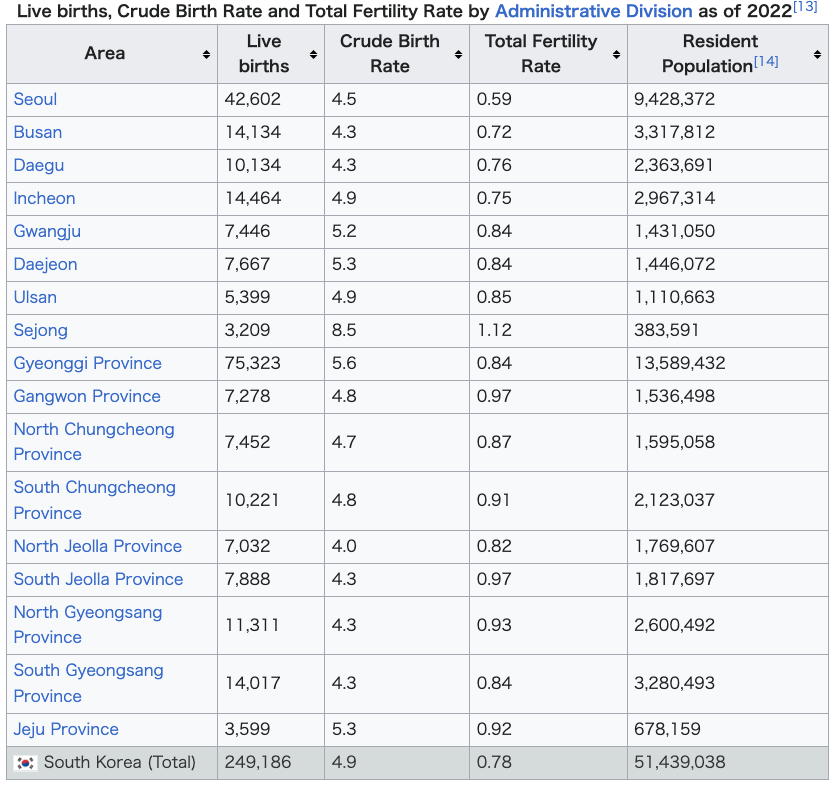 |
2022年の行政区分別の出生数、粗出生率、合計特殊出生率 |
| Causes of fertility decline Government policy After the post-World War II baby boom led to a drastic population increase, the South Korean government implemented an anti-natalistic policy in the 1960s. This government program mandated that South Korean healthcare centers provide a family planning consultation by introducing traditional contraception methods including intrauterine devices, vasectomies, and condoms to the public.[3] Sex preference In the twentieth century, selective abortion of female fetuses had an important impact on the low birth rate.[15] In Korea, there was a strong sex preference for a son because of a focus on the preservation of the family name.[16] From 1981 to 1988, the sex ratio at birth continued to increase to about 116.55 males to 100 females in the early 1990s.[16] The natural human sex ratio at birth is around 105 males to 100 females, so anything higher indicates sex-selective abortion. Despite sex-selective abortion being illegal, the number of prospective parents aborting female fetuses after checking the sex increased. As a result, in 1988, the government banned doctors from revealing the sex of a fetus to expecting parents.[16] Education cost Koreans prioritize their children's education, which is in alignment with their Confucian values that emphasize the relationship between higher education and socioeconomic status.[17] Some Korean citizens send their children to expensive hagwon, for-profit after-school educational institutes, in the hope that their children achieve the high results required to enter a prestigious university. In 2009, more than 75% of South Korean children attended private academies.[17] The hagwon curriculum emphasizes English, math, and writing because of the competitiveness of entering the nation's top three universities: Seoul National University, Korea University, and Yonsei University (collectively known as SKY).[17] In Korean society, sending children to hagwon became a social norm to the point that those who cannot afford to send their children to hagwon are regarded by others as irresponsible and ignorant parents.[18][17] In 2005, a national survey revealed that 18.2% of women aged 20 to 29 years chose not to have a second child because of the cost of extra education.[18] Parents prefer no more than one or two children to focus on each child's success with the less financial burden.[18] According to a survey by the Health Ministry in 2012, 90% of people who participated in the survey stated that they are reluctant to have children because of high education cost, including private education fees.[19] Society of extreme competition Korea, like other East Asian countries, has a society with much competition and demands on individuals (from an early age at school and later in the workplace). Long working hours, constant social pressure for excellence generate stress and fear of failure among people, especially young people (this may also explain why Korea has one of the highest suicide rates in the world). As a result, many Koreans choose not to have children and sometimes even to remain single. And most married couples wish to have only one child to devote more means and energy to the educational and professional success of that one child. Female labor force As the economy has developed, more South Korean women entered university, resulting in a growth in the female workforce.[18] More women have postponed marriage and pursued improvement of their standard of living rather than having children.[18] From 1985 to 2007, the average age at which a South Korean woman first married increased from 24.1 years to 28.1 years.[18] Moreover, the female college enrollment rate also increased from 31.3% in 1990 to 83.8% in 2008.[citation needed] As the percent of women working outside the home increased from 42.8% in 1980 to 50.2% in 2005, the birth rate also decreased from 6.0 children per woman in 1960 to 1.13 per woman in 2006.[citation needed] Increased divorce rate The divorce rate increased by 70% from 1970 to 2000 in South Korea. Divorce is the most significant event that affects family dissolution, which results in a low fertility rate.[20] Even though divorce affected birth rate slightly overall from 1970 to 2000, after the economic crisis in 1997, the rapid increase in the divorce rate affected the decrease in the birth rate.[20][21] In the economic crisis, many families were dissolved as they could not afford to support their family members. The crude divorce rate (divorces per 1,000 population) increased to 2 in 1997 and rose rapidly to 2.5 in the following year. In 2003, the crude divorce rate jumped again to 3.5. Longevity In the first half of the 1950s, life expectancy was only 42 years on average (37 for men, 47 for women). South Korea now has one of the highest life expectancies, 15th in the world. The average baby born in South Korea can expect to live to the age of 82 years (79 for men, and 85 for women). In contrast, the global average is 72 years (70 for men, 74 for women). The UN projects life expectancy will continue to improve; by 2100, the average baby born in South Korea will live to the age of 92 (89 for men, and 95 for women). A separate study published in the Lancet showed that women in South Korea are projected to be the first in the world to have an average life expectancy above 90 – with the researchers predicting a 57% chance this will happen by 2030.[22] |
出生率低下の原因 政府の政策 第二次世界大戦後のベビーブームによる人口の急激な増加の後、韓国政府は1960年代に反出生主義政策を実施した。この政府プログラムでは、韓国の医療セ ンターが家族計画の相談を行うことを義務付け、子宮内避妊器具、パイプカット、コンドームなどの伝統的な避妊方法を一般に紹介した。[3] 性別選択 20世紀には、女児の胎児を選択的に中絶することが少子化に大きな影響を与えた。[15] 韓国では、家名を維持することに重点が置かれていたため、男児を強く望む傾向があった。[16] 1981年から1988年にかけて、出生時の男女比は増加し続け、1990年代初頭には100人の女性に対して116.55人の男性という割合になった。 [16] 自然な人間の出生時の男女比は、100人の女性に対して105人の男性程度であるため、これより高い場合は性別選択中絶が行われていることを示す。性別選 択中絶は違法であるにもかかわらず、性別を確認した後に女児の胎児を中絶する両親の数は増加した。その結果、1988年には政府が医師が胎児の性別を両親 に伝えることを禁止した。[16] 教育費 韓国人は子供の教育を優先しており、これは高等教育と社会経済的地位の関係を強調する儒教の価値観に沿ったものである。[17] 子供たちに名門大学への入学に必要な高い成績を収めることを期待して、営利目的の放課後教育機関である高額なハグウォン(塾)に通わせる韓国国民もいる。 2009年には、韓国の子供の75%以上が私立の学習塾に通っていた。[17] ハグウォンでは、ソウル大学、高麗大学、延世大学(通称 SKY)という国内トップ3の大学への進学競争が激しいため、英語、数学、作文に重点を置いたカリキュラムが組まれている。[17] 韓国社会では、子供をハグウォンに通わせることが社会的な規範となり、ハグウォンに通わせることができない親は、無責任で無知であるとみなされるほどであ る。[18][17] 2005年の全国調査では、20歳から29歳までの女性の18.2%が、追加の教育費を理由に第2子を持たないと回答したことが明らかになった。[18] 親は、経済的負担を軽減し、各子供の成功に集中するために、子供は1人か2人までが良いと考えている。 2012年の保健福祉省の調査によると、調査に参加した人の90%が、私立学校の学費を含む教育費の高騰を理由に、子供を持つことに消極的であると答えて いる。 競争の激しい社会 韓国は他の東アジア諸国と同様、競争が激しく、個人に多くのことを求める社会である(学校では幼い頃から、職場ではその後も)。長時間労働や絶え間ない優 秀さへの社会的プレッシャーは、人々、特に若者たちにストレスや失敗への不安を生み出している(これが韓国が世界でも有数の自殺率を誇る理由のひとつであ る可能性もある)。その結果、多くの韓国人が子供を持たないことを選択し、時には独身のままでいることさえある。そして、ほとんどの既婚カップルは、その 子供一人の教育や職業上の成功により多くの手段とエネルギーを注ぎたいと考え、子供を一人だけ持つことを望んでいる。 女性の労働力 経済が発展するにつれ、より多くの韓国人女性が大学に進学し、その結果、女性労働力人口が増加した。[18] 結婚を先延ばしにして、子供を持つよりも生活水準の向上を追求する女性が増えている。[18] 1985年から2007年の間に、韓国人女性が初めて結婚する平均年齢は24. 1歳から28.1歳に増加した。[18] さらに、女子大生の在学率も1990年の31.3%から2008年には83.8%に増加した。[要出典] 1980年の42. 1980年の42.8%から2005年には50.2%に増加したため、出生率も1960年の女性1人当たり6.0人から2006年には1.13人に減少し た。 離婚率の増加 韓国では、1970年から2000年にかけて離婚率が70%増加した。離婚は家族崩壊に最も大きな影響を与える出来事であり、その結果として出生率が低下 する。[20] 1970年から2000年にかけて、離婚が出生率に与える影響は全体としてわずかであったが、1997年の経済危機以降は、離婚率の急激な上昇が出生率の 低下に影響を与えた。[20][21] 経済危機の中で、多くの家庭が家族を養う余裕がなくなり、解散した。粗離婚率(人口1,000人当たりの離婚件数)は1997年に2件に増加し、翌年には2.5件に急増した。2003年には、粗離婚率は再び3.5件に急増した。 長寿 1950年代前半には、平均寿命はわずか42歳(男性37歳、女性47歳)であった。現在、韓国は世界で15番目に高い平均寿命を誇る国の一つである。韓 国で生まれた赤ちゃんの平均余命は82歳(男性79歳、女性85歳)である。これに対し、世界の平均寿命は72歳(男性70歳、女性74歳)である。 国連は、平均寿命は今後も延び続けると予測しており、2100年には韓国で生まれた新生児の平均寿命は92歳(男性89歳、女性95歳)に達するとしてい る。Lancet誌に掲載された別の研究では、韓国の女性が世界で初めて平均寿命が90歳を超えると予測されている。研究者は、2030年までにその可能 性が57%あると予測している。[22] |
| Effects The biggest consequence of South Korea's aging is that the quality of life for the elderly decreases. The main reason for this is that the elderly lack the income to live decent lives. Over 40% of South Koreans aged 65 and above live in poverty, which is the highest rate among the OECD countries.[23] The government has sought to support senior citizens by providing temporary and direct support to those in poverty. There is a limit to how old people can live in a way that contributes to society. It can be said that poverty caused by the exclusion of the elderly from the labor market is difficult to solve, and can only be solved through social respect and support for the elderly.[24] As the aging population of South Korea is rapidly increasing, one of the major effects of this is that more people will be requiring frequent hospital visits and access to physicians, beds, and other healthcare services (Kang et al., 2023). Not all elderly in South Korea have easy access to these services and hospital/clinic locations. A study which used an “Enhanced Two-Step Floating Catchment Area” method was able to measure the spatial accessibility among the older populations in South Korea (Kang et al., 2023). This study took place in Seoul, Busan, Daegu, Incheon, Gwangju, Daejeon, and Ulsan. Results showed that those who had the greatest accessibility to healthcare services were located in the bigger cities such as Seoul and in fact, areas with the highest elderly population had the lowest accessibility rates to nearby health care services. (Kang et al., 2023). Possible solutions to this suggest that mobile vans could be a potential way to reach these regions with a high aging population. In the future, the aging population is expected to increase. It is important that South Korea begins to prepare for the future demands of these effects. First, making sure that all elderly has spatial accessibility that deems sufficient within urban locations (Kang et al., 2023). The elderly’s proximity to nearby parks, nature, social services, and healthcare facilities should be increased (Kang et al., 2023). Chul Chung, President of Korea Economic Research Institute said:[25] "The declining fertility rate leads to a decline in the workforce and purchasing power and slowing economic growth, which in turn directly affects the sustainability of corporate management, meaning companies need to actively address the issue." — Chul Chung, President of Korea Economic Research Institute Future population The Ministry of Gender Equality and Family showed that the Korean youth population was 14 million in 1980. However, the youth population decreased significantly to 10.2 million in 2012, constituting 20.4% of the country's total population.[26] This decline of the youth population is caused by the low birth rate and will affect the future population count. In 2013, the Korean government revealed that if the fertility rate continues to decrease, the number of people ages 9 to 24 years old will decline by 50% from 2013 in 2060.[26] Under the low growth scenario, the working age population is projected to drop from 33.48 million people in 2017 to 14.84 million people (44.1% of the total population) in 2067.[27] This trend will affect South Korea socially and economically in the long term.[28] Because the number of children continues to decrease, school closures continue to increase.[28] If this trend continues, schools will need to be consolidated and rural city administrations will need to be merged to reduce unnecessary personnel and expenditures.[28] South Korea also has an aging society, which means that there are a greater number of senior citizens with a smaller number of young people to support them.[28] A survey from the Health Ministry in 2012 reported that more than 83% of respondents believe that this aging society will lead to more taxes and a labor shortage.[19] Productive age population While the number of elderly people is increasing, the number of elderly supported by every 100 working-age people is expected to soar from 37.6 in 2019 to 120.2 in 2067, among the highest levels in the world.[2] Economic People have different economic needs and different degrees of contribution to the economy at each stage of their lives. In general, people do not earn income in their childhood, but they do have access to learning activities under the care of their parents. People tend to generate income until they retire; in retirement they depend on money they saved in their working years.[24] The population decline resulting from a low fertility rate could diminish South Korea's potential economic growth to less than 2% as the labor force declines.[28] This lack of economic growth could affect South Korea's sovereign credit and fiscal strength after 2030.[28] Furthermore, the declining number of children could also affect the Korean Army's military budgets.[28] As the number of eligible young men is decreasing, the government could pressure the armed forces to maintain the current military structure while their budget decreases, as national funds are redirected to the problems of aging and low fertility.[28] The decline in fertility rates can lead to a positive effect known as "the demographic dividend" under certain circumstances. This outcome can lead to a boost in a country's economic growth by altering its age distribution, resulting in a greater number of working-age individuals and fewer dependent young children and elderly people.[29] Military South Korea's declining birth rate has become a national-security challenge: Fewer young men are around for military service. South Korea's active military will shrink to half a million personnel by 2022, from the current total of about 600,000. The military service, which lasts between 18 and 22 months, is viewed as a rite of passage for South Korean men. But the pool of able-bodied draftees is projected to shrink by nearly half over the next two decades, according to South Korea's Defense Ministry.[30] |
影響 韓国の高齢化による最大の影響は、高齢者の生活の質が低下することである。その主な理由は、高齢者がまともな生活を送るための収入が不足していることであ る。65歳以上の韓国人の40%以上が貧困層であり、これはOECD諸国の中で最も高い割合である。[23] 政府は、貧困層に一時的かつ直接的な支援を提供することで高齢者を支援しようとしている。高齢者が社会に貢献できる形で生きるには限界がある。労働市場か ら高齢者が排除されることによる貧困は解決が難しく、高齢者に対する社会的尊敬と支援を通じてのみ解決できると言える。 韓国の高齢化率が急速に上昇している中、その主な影響のひとつとして、頻繁な通院や医師、ベッド、その他の医療サービスを必要とする人々が増えることが挙 げられる(Kang et al., 2023)。韓国の高齢者すべてが、これらのサービスや病院・診療所の場所に簡単にアクセスできるわけではない。「拡張2段階フローティング・キャッチメ ント・エリア」という手法を用いた研究により、韓国の高齢者人口における空間的アクセス可能性を測定することができた(Kang et al., 2023)。この研究はソウル、釜山、大邱、仁川、光州、大田、蔚山で行われた。その結果、医療サービスへのアクセスが最も良いのはソウルなどの大都市で あり、実際、高齢者人口が最も多い地域では、近隣の医療サービスへのアクセス率が最も低いことが分かった。(Kang et al., 2023)。 この問題に対する解決策として、移動式バンが高齢化率の高い地域へのアクセスを可能にする可能性があることが示唆されている。今後、高齢者人口は増加する と予想される。韓国は、こうした影響に対する将来的な需要に備え始めることが重要である。まず、都市部において、すべての高齢者が十分な空間的アクセスを 確保できるようにすること(Kang et al., 2023)。高齢者が近隣の公園、自然、社会サービス、医療施設に近づけるようにすべきである(Kang et al., 2023)。 韓国経済研究院のChul Chung院長は次のように述べている。 「出生率の低下は労働力と購買力の低下、経済成長の鈍化につながり、ひいては企業の経営持続性に直接的な影響を及ぼすため、企業は積極的にこの問題に取り組む必要がある」と述べた。 — 韓国経済研究院理事長、チョル・チョン 将来の人口 男女平等家族部は、韓国の若者人口は1980年には1,400万人であったことを示している。しかし、若者人口は2012年には1,020万人へと大幅に 減少しており、これは同国の総人口の20.4%にあたる。[26] この若者人口の減少は出生率の低下によるもので、将来的な人口数にも影響を与えることになる。2013年、韓国政府は、出生率が低下し続けた場合、 2013年から2060年にかけて9歳から24歳までの人口が50%減少するとの見通しを示した。 [26] 低成長シナリオでは、生産年齢人口は2017年の3,348万人から2067年には1,484万人(総人口の44.1%)に減少すると予測されている。 [27] この傾向は長期的に韓国の社会と経済に影響を与えることになるだろう。[28] 子供の数が減り続けているため、学校の閉鎖も増加し続けている。[28] この傾向が続けば、学校の統廃合や地方都市の行政の統合が必要となり、不必要な人員や支出を削減しなければならなくなるだろう。[28] 韓国は高齢化社会にも直面しており、高齢者の数が増加する一方で、高齢者を支える若年層の数は減少している。[28] 2012年の保健省の調査では、回答者の83%以上が、この高齢化社会により、増税と労働力不足がもたらされると信じていると報告されている。[19] 生産年齢人口 高齢者の数が増加する一方で、生産年齢人口100人当たりの高齢者扶養数は、2019年の37.6人から2067年には120.2人に急増し、世界でも最高水準になると予想されている。 経済 人々は、人生の各段階において異なる経済的ニーズと経済への貢献度を持っている。一般的に、子供時代には収入を得ることはないが、両親の保護の下で学習活動を行うことはできる。人々は退職するまで収入を得る傾向にあり、退職後は現役時代に蓄えた資金に頼ることになる。 出生率の低下による人口減少は、労働人口の減少に伴い、韓国の潜在的な経済成長率を2%未満に低下させる可能性がある。[28] この経済成長の欠如は、2030年以降の韓国のソブリン債の信用力と財政力に影響を及ぼす可能性がある。 [28] さらに、子供の数の減少は韓国軍の軍事予算にも影響を及ぼす可能性がある。[28] 適齢期の若い男性の数が減少しているため、政府は軍に対して、予算が減少する一方で現在の軍事体制を維持するよう圧力をかける可能性がある。その一方で、 国民の資金は高齢化と少子化の問題に再配分されることになる。[28] 出生率の低下は、一定の条件下では「人口ボーナス」として知られる好影響をもたらす可能性がある。この結果、年齢構成が変化し、労働年齢人口が増加し、扶養を必要とする年少者や高齢者が減少することで、国の経済成長が促進される可能性がある。 軍事 韓国では出生率の低下が国家安全保障上の課題となっている。兵役につく若い男性が減少しているのだ。韓国の現役軍人は、現在の約60万人から2022年に は半分の50万人に減少する見通しである。18ヶ月から22ヶ月間続く兵役は、韓国の男性にとって通過儀礼とみなされている。しかし、韓国国防部による と、今後20年間で、健康な徴集兵の数はほぼ半減すると予測されている。[30] |
| Government policies South Korea's measures to combat aging and its effects include strengthening income security for retirees, finding ways to increase productivity to compensate for the reduction of the working-age population, and taking the leap to an aging-friendly economy.[31] Promotion of pro-natalist policies The Korean government implemented a new policy in 2006 that aims to improve reproductive healthcare services to resolve the low fertility rate.[32] However, this policy had no effect to increase the fertility rate. Therefore, the Committee on Ageing and Future Society (CAFS) was founded in 2003 to increase the fertility rate and to prepare for the problem of an upcoming aging society.[32] The Presidential Committee on Aging Society and Population Policy, which is reinforced by CAFS, announced the First Basic Planning for Low Fertility and Aged Society in 2006.[32] This planning includes support for daycare and preschool education and economic benefits for multi-child families, such as social insurance.[32] The Korean government announced the pro-natal policies to increase the fertility rate in South Korea on December 2, 2018.[33] The purpose of this policy is to create a positive environment for parents to have more than 2 children by decreasing medical and child-rearing expenses and providing a better support system for working mothers.[33] Moon Jae-in, the president in South Korea who was elected in 2017, announced that the government will expand a subsidy for parents of young children to triple the proportion of infants and toddlers looked after by publicly run centers.[33] The government expects that before 2022, the number of newborn babies could decrease to less than 300,000 per year, so their goal is to maintain a rate of more than 300,000 newborn babies every year because of the continuous decrease in fertility rate.[33] The Ministry of Health and Welfare stated that this government's improved plan would increase the standard of living for an entire generation and resolve the problem of low fertility rate in the long term.[33] Starting in 2019, the government promised to provide financial support of medical expenses for infants younger than 1 year.[33] Additionally, the government plans to offer financial support for preschool children by 2025.[33] The government also increased financial support for married couples who have difficulty conceiving a child. That married couple could be subsidized more than 70% of the medical cost for artificial insemination for a maximum of four sessions.[33] Starting in the second half of 2019, according to the Ministry of Health and Welfare, parents who have children younger than 8 years old can leave work an hour earlier, and paid paternity leave is increased to 10 days.[33] Strengthening income security system stable retirement As the average life expectancy grows older, the problem of poverty may intensify. Accordingly, the 3rd Basic Plan intends to strengthen the public and private retirement income security system. To relieve blind spots in public pensions, the government will expand women's pension entitlements and increase their participation in national pensions such as one-time and part-time special employment. The plan is to establish a one-person national pension system. The plan is to increase membership by easing the requirements for housing pension and farmland pension. They will improve the financial system in preparation for long-term risks due to the safety assets of the elderly and expand the retirement preparation services so that they can prepare for their own retirement.[31] Expanding conditions that can improve the quality of life of the elderly To improve the quality of life of the elderly, they will expand the conditions to improve the quality of life for the elderly. This includes efforts to create a safe living environment. Specifically, the process includes vitalizing the health mileage system, strengthening chronic disease management, expanding comprehensive nursing care and nursing services, strengthening long-term care insurance system quality management, and reinforcing hospice palliative care services. They will support the health of the elderly by supporting them. The company plans to support active retirement by expanding social participation opportunities such as developing leisure culture tailored to the elderly and expanding participation in volunteer support. They will create a safe living environment by expanding rental housing for the elderly, mandatory safety training for senior drivers, and reducing traffic accidents for elderly pedestrians through the establishment of elderly protection zones.[31] The combination of South Korea’s rapid aging population and the slowing economy has left many children unable to care for their aging parents. This has left many elderly people in South Korea living alone and supporting themselves with little financial means. Research from 2006 to 2016 showed that elderly people who live with family have overall greater life satisfaction than those who live alone (Roh & Weon, 2022). Those elderly who lived alone reported higher levels of poverty and thoughts of suicide (Roh & Weon, 2022). The impact that living arrangements have on the elderly were measured by an individual’s overall thoughts and impressions on their health conditions, living conditions, social network, and their overall environment (Roh & Weon, 2022). Researchers named Shin and Sok used a 20-question survey created by Yun which asked elderly participants about their emotions and life experiences. Results found that those living with family members were less likely to consider suicide, develop depression, and experience deteriorating health conditions (Roh & Weon, 2022). This shows one way the lives of elderly people in South Korean can be improved by living with friends and family instead of by themselves. Not everyone has the means to live with relatives or close friends. In this case, several studies reported that elderly who live alone but who partake in regular physical activity and social relationships have higher overall life satisfaction (Roh & Weon, 2022). Manpower utilization plan compared to the reduction of productive population As the decrease in the number of people available for production began in earnest in 2016, they are devising measures to utilize women, middle-aged and foreign workers. Women's employment will be activated by diversifying the form of work such as part-time work and strengthening the reemployment support system for career-breaking women. Korea will strengthen the working base of middle-aged and older workers by spreading the wage peak system to establish the 60-year-old retirement age system and mandatory life support service. In order to expand the recruitment of overseas talented individuals, especially in areas where there is a shortage of domestic specialists, the government will provide opportunities for long-term employment and settlement, and establish a mid- to long-term immigration policy to utilize foreign workers.[31] Leap to an age-friendly economy As the elderly population grows, active efforts for the aged-friendly industry are needed. Therefore, the 3rd basic plan aims to foster the industrial sectors such as medical care, tourism, and food related to the elderly, and to support the development of universal design and user-oriented elderly-friendly products. Meanwhile, in order to cope with the reduction of school age population due to low birth rate, they will promote university structural reform, teacher training, and reschedule supply and demand plan.[31] In order to cope with the declining population in rural areas due to aging and urbanization, the government also proposes measures to revitalize return-to-home villages. It plans to reform the national pension system and stabilize the income base of health insurance to manage the financial risk of social insurance. The government will plan to reform special occupational pension plans. For the efficient use of national finance, the government proposes measures to reorganize quasi-duplicate financial projects, expand revenue bases, and manage mid- to long-term financial risks.[31] |
政府政策 韓国の高齢化対策とその影響には、退職者の所得保障の強化、生産性を向上させて生産年齢人口の減少を補う方法の模索、高齢者にやさしい経済への飛躍などが含まれる。[31] 出生率向上政策の推進 韓国政府は2006年に、少子化対策としてリプロダクティブ・ヘルスケアサービスの改善を目的とした新たな政策を実施した。[32] しかし、この政策は出生率の増加には効果を上げなかった。そのため、出生率の増加と迫り来る高齢化社会への備えを目的として、2003年に「高齢化と未来 社会委員会(CAFS)」が設立された。 [32] 少子高齢社会対策会議は、CAFSによって強化され、2006年に「第1次少子高齢社会対策基本計画」を発表した。[32] この計画には、保育・幼児教育の支援や、社会保険など多子世帯への経済的給付が含まれている。[32] 韓国政府は2018年12月2日、韓国の出生率を上げるための出生促進政策を発表した。[33] この政策の目的は、医療費や子育て費用を削減し、働く母親への支援体制を充実させることで、2人以上の子供を持つ親にとってより良い環境を作り出すことである。[33] 2017年に当選した韓国の大統領である文在寅は、政府が幼児を持つ親への助成金を拡大し、公立の保育施設で保育される乳幼児の割合を3倍に増やすと発表 した。 [33] 政府は2022年までに新生児の数が年間30万人を下回る可能性があると予想しており、出生率の低下が続いているため、毎年30万人以上の新生児の数を維 持することを目標としている。[33] 保健福祉省は、この政府の改善された計画は、ある世代全体の生活水準を向上させ、長期的に少子化問題を解決するだろうと述べた。[33] 2019年より、政府は1歳未満の乳児の医療費を財政支援することを約束した。[33] さらに、政府は2025年までに未就学児への財政支援を行う計画である。[33] また、政府は、子供を授かりにくい夫婦への経済的支援も増額した。その夫婦は、人工授精にかかる医療費の70%以上を、最大4回まで補助される可能性があ る。[33] 2019年後半から、保健福祉省によると、8歳未満の子供を持つ親は1時間早く退社でき、有給の父親の育児休暇は10日に延長される。[33] 所得保障制度の強化 安定的な老後 平均余命の高齢化に伴い、貧困問題が深刻化する可能性がある。このため、第3次基本計画では、公的・私的年金による所得保障制度の強化を図る。公的年金の 盲点を解消するため、政府は女性の年金受給権を拡大し、臨時雇用やパートタイムの特別雇用など国民年金への女性の参加を促進する。 国民年金の一人加入制度を創設する。 住宅年金や農地年金の要件を緩和して加入者を増やす。 高齢者の安全資産による長期的なリスクに備えて金融制度を改善し、老後の準備サービスを拡大して、老後の準備をできるようにする。[31] 高齢者の生活の質を向上できる条件を拡大する 高齢者の生活の質を向上させるため、高齢者の生活の質を向上させる条件を拡大する。これには、安全な生活環境を創出するための取り組みが含まれる。具体的 には、保健マイレージ制度の活性化、慢性疾患管理の強化、総合的な介護・看護サービスの拡大、介護保険制度の質的管理の強化、ホスピス緩和ケアサービスの 強化などが含まれる。高齢者の健康を支援することで、高齢者の健康をサポートする。高齢者に適した余暇文化の開発やボランティア支援への参加拡大など、社 会参加の機会を拡大することで、積極的な老後を支援する計画である。高齢者向け賃貸住宅の拡大、高齢ドライバーに対する安全講習の義務化、高齢者保護区域 の設定による高齢歩行者の交通事故削減などにより、安全な生活環境を創出する。 韓国の急速な高齢化と経済の低迷が相まって、多くの子供たちが年老いた親の面倒を見ることができなくなっている。その結果、韓国では多くの高齢者が一人暮 らしとなり、わずかな経済的余裕で生活を支えている。2006年から2016年にかけての調査では、家族と同居する高齢者は、一人暮らしの高齢者よりも全 体的に生活満足度が高いことが示された(Roh & Weon, 2022)。一人暮らしの高齢者は、より高いレベルの貧困と自殺願望を報告した(Roh & Weon, 2022)。 高齢者の居住形態が及ぼす影響は、個人の健康状態、生活環境、社会ネットワーク、および全体的な環境に対する考えや印象によって測定された(Roh & Weon, 2022)。シンとソクという名の研究者は、ユンが作成した20問のアンケートを使用し、高齢の回答者たちに感情や人生経験について尋ねた。その結果、家 族と同居している人々は、自殺を考えたり、うつ病を発症したり、健康状態が悪化したりする可能性が低いことが分かった(Roh & Weon, 2022)。 これは、韓国の高齢者の生活が、一人暮らしではなく友人や家族と一緒に暮らすことで改善される可能性があることを示している。誰もが親戚や親しい友人と一 緒に暮らす手段を持っているわけではない。この場合、いくつかの研究では、一人暮らしだが定期的に運動や社会的な交流を行っている高齢者は、全体的な生活 満足度が高いことが報告されている(Roh & Weon, 2022)。 生産人口の減少と比較した労働力活用計画 生産可能人口の減少が2016年から本格化したため、女性、中高年、外国人労働者の活用策を講じている。女性の雇用は、パートタイムなど就業形態の多様化 や、キャリアを中断した女性の再就職支援制度の強化により活性化する。韓国は、60歳定年制と生活支援サービスの義務化を定着させ、中高年労働者の就労基 盤を強化する。海外の優秀な人材の採用を拡大するため、特に国内の専門家が不足している分野において、政府は長期雇用と定住の機会を提供し、外国人労働者 活用の中長期移民政策を樹立する。 高齢者に優しい経済への飛躍 高齢者人口の増加に伴い、高齢者に優しい産業への積極的な取り組みが必要である。そのため、第3次基本計画では、高齢者向けの医療、観光、食品などの産業 分野の育成、ユニバーサルデザインやユーザー志向の高齢者に優しい製品の開発を支援することを目指している。一方、少子化による生産年齢人口の減少に対応 するため、大学構造改革、教員養成、需給計画の見直しを推進するとしている。 また、高齢化と都市化による農村地域の人口減少に対応するため、帰郷・帰村の活性化策を打ち出している。また、社会保険の財政リスクを管理するために、全 国年金制度の改革と、医療保険の収入基盤の安定化を計画している。政府は、特別な職業年金制度の改革も計画している。国民の財政を効率的に活用するため に、政府は、事実上重複している財政プロジェクトの再編、収入基盤の拡大、中長期的な財政リスクの管理を提案している。[31] |
| Lewis-Kraus, Gideon, "The End of
Children: Birth rates are crashing around the world. What does that
mean for our future?", The New Yorker, 3 March 2025, pp. 28–36, 38–41.
"A population will be stable if it reproduces at the 'replacement
rate,' or about 2.1 babies per mother.... [D]eclining [human] fertility
is a near-universal phenomenon.... Giorgia Meloni, the Prime Minister
of Italy, has said that her country is 'destined to disappear.' One
Japanese economist runs a conceptual clock that counts down to his
country's final child: the current readout is January 5, 2720. [p. 28.]
South Korea has a fertility rate of 0.7. This is the lowest rate of any
nation in the world. It may be the lowest in recorded history. If that
trajectory holds, each successive generation will be a third the size
of its predecessor. Every hundred contemporary Koreans of childbearing
age will produce... about twelve grandchildren." (p. 30.) |
ルイス・クラウス、ギデオン、「子どもの終焉:出生率は世界中で急落し
ている。それは私たちの未来にとって何を意味するのか?」、ニューヨーカー、2025年3月3日、28-36、38-41ページ。「人口は、母親一人当た
りおよそ2.1人の子どもを産む『置換率』で再生産される場合、安定する。人間)の出生率の低下はほぼ世界的な現象である。イタリアのジョルジャ・メロー
ニ首相は、自国は「消滅する運命にある」と述べた。日本のエコノミストの一人は、自国の最後の子供が生まれるまでの時間をカウントダウンする概念上の時計
を運営している。現在の表示は2720年1月5日である。[p. 28.]
韓国の出生率は0.7である。これは世界で最も低い率である。記録史上最低の率かもしれない。この傾向が続けば、世代が代わるごとに人口は3分の1に減少
することになる。現代の韓国の100人の出産適齢期の女性が産む子供の数は...約12人の孫である。」(p. 30.) |
| https://en.wikipedia.org/wiki/Aging_of_South_Korea | |
| Japan has the highest proportion
of elderly citizens of any country in the world.[1] 2014 estimates
showed that about 38% of the Japanese population was above the age of
60, and 25.9% was above the age of 65, a figure that increased to 29.1%
by 2022. By 2050, an estimated one-third of the population in Japan is
expected to be 65 and older.[2] Population aging in Japan preceded
similar trends in other countries, such as South Korea and China.[3][4] The ageing of Japanese society, characterized by sub-replacement fertility rates and high life expectancy, is expected to continue. Japan had a post-war baby boom between 1947 and 1949, followed by a prolonged period of low fertility.[5] These trends resulted in the decline of Japan's population after reaching a peak of 128.1 million in October 2008.[6] In 2014, Japan's population was estimated to be 127 million. This figure is expected to shrink to 107 million (by 16%) by 2040 and to 97 million (by 24%) by 2050 if this current demographic trend continues.[7] A 2020 global analysis found that Japan was one of 23 countries that could see a total population decline of 50% or more by 2100.[8] These trends have led some researchers to claim that Japan is transforming into a "super-ageing" society in both rural and urban areas.[9] Japanese citizens largely view Japan as comfortable and modern, with no widespread sense of a "population crisis".[6] The Japanese government has responded to concerns about the stresses demographic changes place on the economy and social services with policies intended to restore the fertility rate as well as increase the activity of the elderly in society.[10] Japan's population in three demographic categories, from 1920 to 2010, with projections to 2060 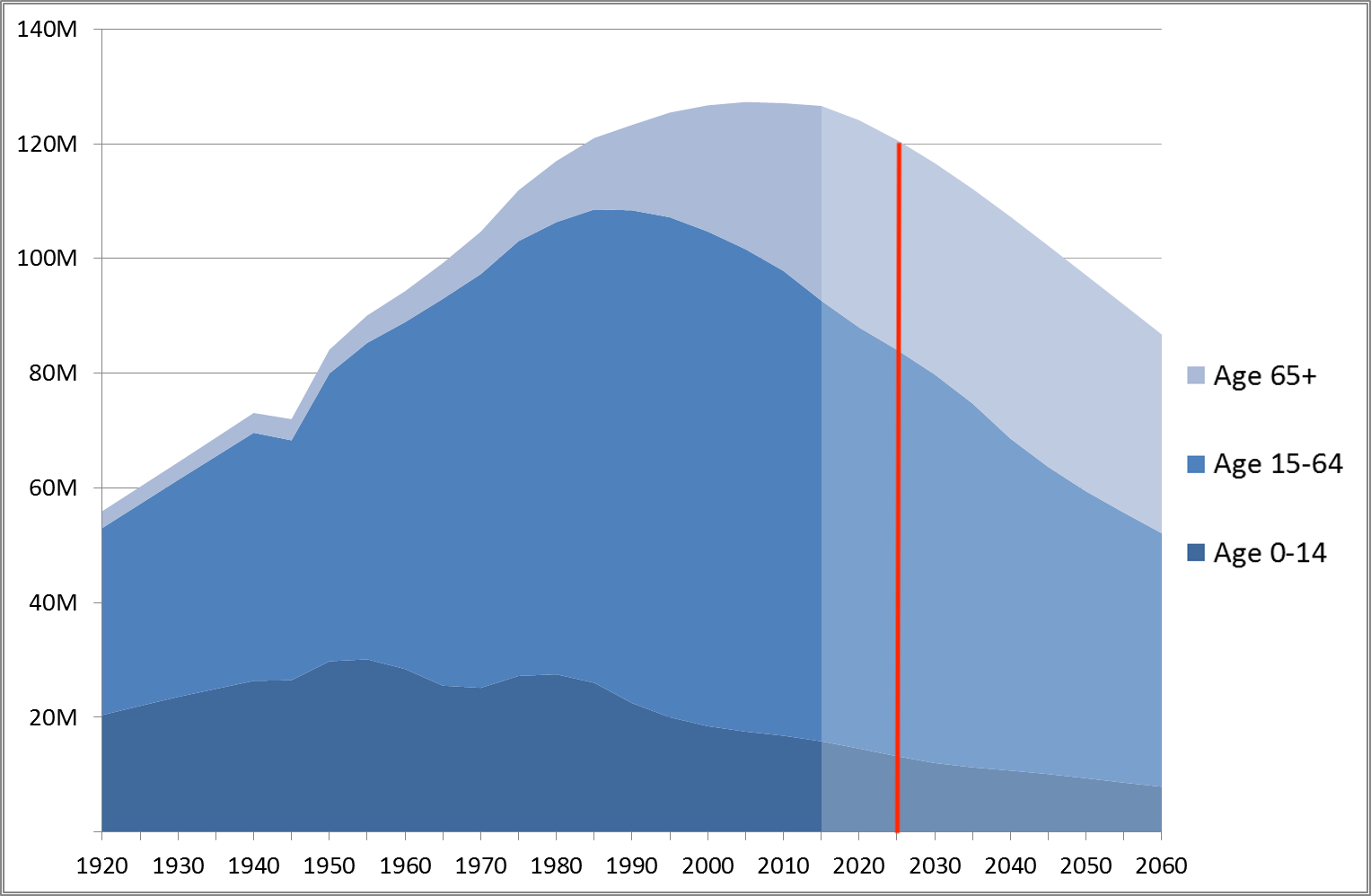 |
日本は世界で最も高齢者の割合が高 い国である。[1]
2014年の推計によると、日本の人口の約38%が60歳以上、25.9%が65歳以上であり、2022年には29.1%に増加すると予測されている。
2050年には、日本の人口の3分の1が65歳以上になると推定されている。[2]
日本における人口の高齢化は、韓国や中国など他の国々における同様の傾向に先んじて起こった。[3][4] 人口置換水準を下回る出生率と高い平均余命を特徴とする日本の高齢化は、今後も継続すると見込まれている。日本では、1947年から1949年にかけて戦 後のベビーブームが起こったが、その後は長期間にわたって出生率が低下した。[5] これらの傾向により、2008年10月に1億2810万人でピークに達した後、日本の人口は減少に転じた。[6] 2014年の日本の人口は1億2700万人と推定されている。この数値は、現在の人口動態の傾向が続いた場合、2040年までに1億700万人(16% 減)、2050年までに9700万人(24%減)にまで減少すると予測されている。 [7] 2020年の世界的な分析では、2100年までに総人口が50%以上減少する可能性がある23カ国のうちの1つとして日本が挙げられている。[8] これらの傾向により、一部の研究者は、日本が都市部と地方の両方で「超高齢化社会」へと変貌しつつあると主張している。[9] 日本国民は概ね、日本を快適で近代的な国と捉えており、「人口危機」という感覚は広まっていない。[6] 政府は、人口動態の変化が経済や社会サービスに与える影響への懸念に応えるため、出生率の回復と高齢者の社会参加を促す政策を実施している。[10] 1920 年から2010年までの日本の人口動態3区分、2060年までの予測値  |
| Hyper-Aged Society, Japan | 超高齢化社会・日本 |
研究代表者の経歴:池田光穂(いけだ・みつほ)

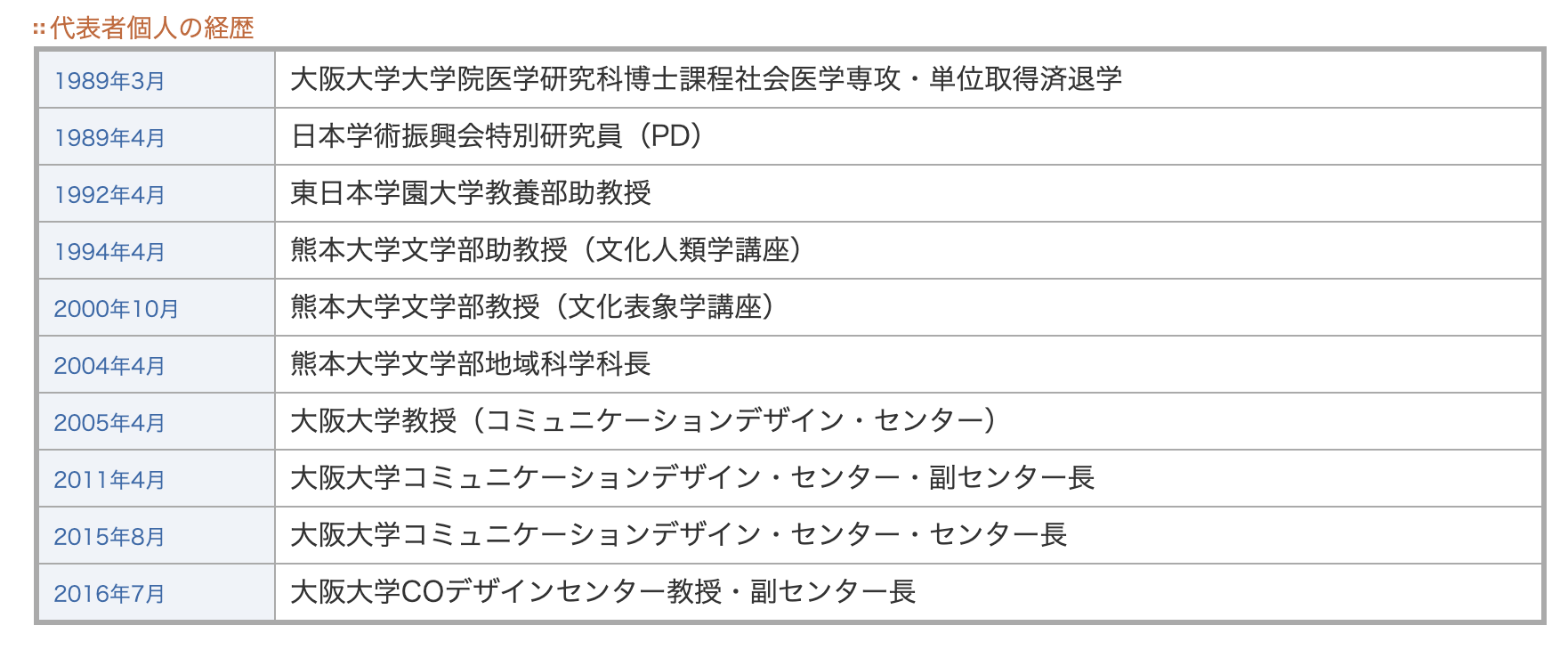
ロードマップ
++++
資料編
++++
| 韓国、来年から人口減に 2065年に高齢化で日本逆転
【日経新聞:2019.03.28】【ソウル=鈴木壮太郎】韓国統計庁は28日、将来人口推計を発表した。総人口は早ければ2019年の5165万人を
ピークに減少に転じる。人口に占める65歳以上の高齢者の割合も65年に46%に達し、高齢化では日本を抜いて経済協力開発機構(OECD)加盟の先進国
のなかで首位になる。急速な少子高齢化は韓国経済にも影響を与えそうだ。/韓国は5年ごとに人口推計を発表している。前回発表は16年で、次回は21年に
予定していた。ただ2月末に発表した18年の合計特殊出生率(1人の女性が生涯に産む子供の数)が想定以上に低い0.98となり、初めて1を下回って世界
で最低水準に落ち込んだことから、人口を推計し直して発表を前倒しした。/出生率と寿命を低く見積もる「低位シナリオ」の場合、16年の発表では23年が
人口のピークで、その後減りはじめると予想していた。今回の発表では人口減が4年早く訪れる。総人口は67年に3365万人まで減り、1972年の水準に
なる。/高齢化も急速に進む。2017年時点の65歳以上の人口比は14%。国連の人口推計(15年)と比べると日本のほぼ半分の水準にとどまる。
OECD加盟国の中でも低い方だが、65年にはほぼ2人に1人が65歳以上となる見通しだ。生産年齢人口(15~64歳)も17年は73%と、OECD加
盟国のなかで最高だが、少子高齢化によって65年は46%(中位シナリオ)と、日本(51%)を抜いて最低になる。/韓国で少子高齢化が急速に進んでいる
のは、子どもを産み育てるのが難しい社会になっていることがある。15~29歳の青年失業率は18年に9.5%に達し、若者の就職難は社会問題化してい
る。経済力の問題から結婚しない人も増え、20~44歳の未婚率は男性が58%、女性は48%(15年)に達した。結婚しても教育費負担が重く、出産をた
めらう夫婦が多い。/急速な少子高齢化は経済の活力低下につながる。現在の潜在成長率は2.7~2.8%だが、現代経済研究院の洪俊標(ホン・ジュン
ピョ)研究委員は「30年以降は潜在成長率が1%台まで下がる可能性がある」と予測する。国内では「通貨危機以上の危機だ」(韓国大手紙の朝鮮日報)と警
戒する声が強まっている。/韓国政府は少子高齢化対策に16~18年の3年間で117兆ウォン(約11兆円)をつぎ込んだが、施策が総花的で即効性がな
く、出生率は目標の1.5に上向くどころか低下に歯止めがかからなかった。/文在寅(ムン・ジェイン)政権は昨年12月「低出産・高齢社会政策ロードマッ
プ」を発表。出産・養育費支援の増額や小学校入学までの医療費無料化、育児休暇時の給与引き上げなど、ニーズの高い施策に財源を集中配分し、出生率の引き
上げに腐心する。/ただ急激な出生率の回復は難しいのが現実だ。延世大の成太胤(ソン・テユン)教授は「このままでは年金制度の維持も難しい。移民の受け
入れなど、既存の政策を転換する必要がある」と指摘する。/洪氏も「潜在成長率を高めるには女性が働きやすい環境づくりのほか、移民政策の緩和に加え、規
制緩和や新産業の創出などで投資をしやすい環境づくりをさらに進める必要がある」と、産業政策との連携が重要だと強調する。/ https://www.nikkei.com/article/DGXMZO43047760Y9A320C1FF2000/
retreived at 20190914 |
学習情報(サイト内 in situ)
日韓関係悪化における韓国側の予想
リンク(韓国情報)
リンク
Web-page information in situ.
文献
その他の情報
Copyleft,
CC, Mitzub'ixi Quq Chi'j, 1996-2099